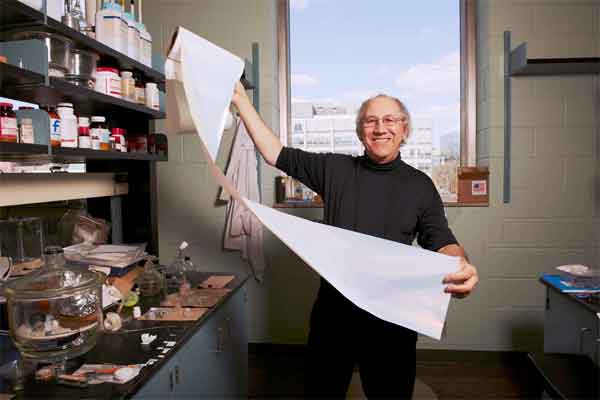Every year, humans advance climate change and global warming — and quite likely our own eventual extinction — by injecting about 30 billion tonnes of carbon dioxide into the atmosphere.
A team of scientists from the University of Toronto (U of T) believes they’ve found a way to convert all these emissions into energy-rich fuel in a carbon-neutral cycle that uses a very abundant natural resource: silicon. Silicon, readily available in sand, is the seventh most-abundant element in the universe and the second most-abundant element in the earth’s crust.
The idea of converting carbon dioxide emissions to energy isn’t new: there’s been a global race to discover a material that can efficiently convert sunlight, carbon dioxide and water or hydrogen to fuel for decades. However, the chemical stability of carbon dioxide has made it difficult to find a practical solution.
“A chemistry solution to climate change requires a material that is a highly active and selective catalyst to enable the conversion of carbon dioxide to fuel. It also needs to be made of elements that are low cost, non-toxic and readily available,” said Geoffrey Ozin, a chemistry professor in U of T’s Faculty of Arts & Science, the Canada Research Chair in Materials Chemistry and lead of U of T’s Solar Fuels Research Cluster.

Geoffrey Ozin and his colleagues believe they have found a way to convert CO₂ emissions into energy-rich fuel (Brian Summers photo)
In an article in Nature Communications published August 23, Ozin and colleagues report silicon nanocrystals that meet all the criteria. The hydride-terminated silicon nanocrystals — nanostructured hydrides for short — have an average diameter of 3.5 nanometres and feature a surface area and optical absorption strength sufficient to efficiently harvest the near-infrared, visible and ultraviolet wavelengths of light from the sun together with a powerful chemical-reducing agent on the surface that efficiently and selectively converts gaseous carbon dioxide to gaseous carbon monoxide.
The potential result: energy without harmful emissions.
“Making use of the reducing power of nanostructured hydrides is a conceptually distinct and commercially interesting strategy for making fuels directly from sunlight,” said Ozin.
The U of T Solar Fuels Research Cluster is working to find ways and means to increase the activity, enhance the scale, and boost the rate of production. Their goal is a laboratory demonstration unit and, if successful, a pilot solar refinery.
Reference(s):
Publication: Wei Sun, Chenxi Qian, Le He, Kulbir Kaur Ghuman, Annabelle P. Y. Wong, Jia Jia, Abdinoor A. Jelle, Paul G. O’Brien, Laura M. Reyes, Thomas E. Wood, Amr S. Helmy, Charles A. Mims, Chandra Veer Singh, Geoffrey A. Ozin. Heterogeneous reduction of carbon dioxide by hydride-terminated silicon nanocrystals. Nature Communications, 2016
Research story: University of Toronto | August 25, 2016 (source)













Comments